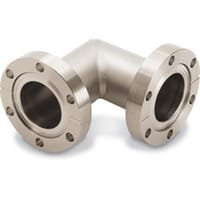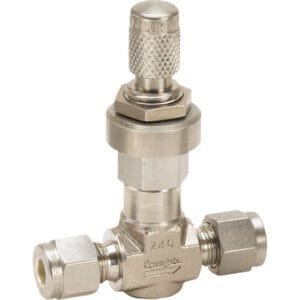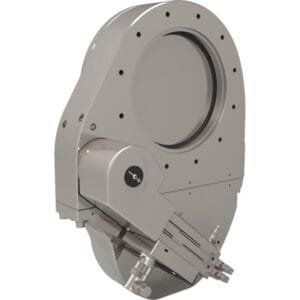ConFlat (CF) UHV Miter 90° Elbows: Essential Components for Precise Vacuum System Integration
ConFlat (CF) UHV Miter 90° Elbows are critical components in the design and operation of ultra-high vacuum (UHV) systems. These elbows are specially engineered to provide smooth directional changes in vacuum tubing, facilitating the seamless integration of various components within a vacuum setup. Made from high-quality 304L stainless steel and featuring ConFlat (CF) knife-edge flanges, these elbows offer leak-tight seals and durable performance, even in the most demanding vacuum environments.
At TFM, we pride ourselves on manufacturing CF UHV Miter 90° Elbows that meet the stringent standards required for precision vacuum systems. Our products ensure that your UHV setup maintains the highest levels of vacuum integrity and performance.
What Are ConFlat (CF) UHV Miter 90° Elbows?
ConFlat (CF) UHV Miter 90° Elbows are vacuum fittings designed to change the direction of vacuum lines at a 90° angle. These elbows are essential for routing vacuum lines in complex configurations while maintaining consistent vacuum performance. The CF flanges on both ends of the elbow provide an airtight seal, ensuring that the integrity of the vacuum is preserved.
These elbows are made from 304L stainless steel, which is known for its excellent corrosion resistance, strength, and suitability for high-vacuum applications. The knife-edge ConFlat flanges provide reliable sealing, which is essential for UHV applications where even the smallest leak can significantly impact system performance.
Key Features of ConFlat (CF) UHV Miter 90° Elbows
1. Durable 304L Stainless Steel Construction
Our ConFlat (CF) UHV Miter 90° Elbows are constructed from 304L stainless steel, offering superior corrosion resistance and long-term durability. This material ensures that the elbows perform optimally in UHV environments, where high vacuum integrity is crucial.
2. Leak-Tight ConFlat Flanges
Each CF UHV Miter 90° Elbow is equipped with knife-edge ConFlat flanges, which create a secure, leak-tight seal when mated with compatible gaskets. This feature is vital in maintaining the ultra-high vacuum necessary for critical applications.
3. Precise 90° Bend for Directional Control
The 90° miter bend allows for precise directional control of vacuum lines, enabling smooth integration into complex vacuum system layouts. The elbow ensures that the flow of gases or materials within the system is unobstructed and consistent.
4. Vibration and Stress Resistance
Designed to withstand mechanical stress and vibrations, CF UHV Miter 90° Elbows provide secure connections that help maintain system stability, even under fluctuating pressure conditions or thermal cycles.
5. Versatile Integration
These elbows are compatible with a wide range of CF flanged components, making them ideal for use in various UHV applications, such as semiconductor manufacturing, space simulation, and material science research.
Applications of ConFlat (CF) UHV Miter 90° Elbows
ConFlat (CF) UHV Miter 90° Elbows are used in a variety of industries and scientific fields where maintaining ultra-high vacuum conditions is critical. Some common applications include:
Semiconductor Manufacturing: These elbows are used in cleanroom environments to direct vacuum lines and equipment connections without compromising vacuum integrity during wafer fabrication, etching, and deposition processes.
Space Simulation Chambers: Used in aerospace applications to simulate space conditions, CF UHV Miter 90° Elbows allow for precise routing of vacuum lines while maintaining the vacuum environment required for testing satellite components and materials.
Material Science and Research: In research labs conducting surface analysis or thin film deposition, these elbows ensure stable vacuum conditions, which are essential for obtaining accurate and reproducible results.
Vacuum Furnace Systems: CF UHV Miter 90° Elbows are ideal for use in high-temperature vacuum furnaces, where precise directional control of vacuum lines helps optimize the heat treatment or material processing conditions.
Why Choose TFM’s ConFlat (CF) UHV Miter 90° Elbows?
At TFM, we specialize in producing ConFlat (CF) UHV Miter 90° Elbows that meet the highest standards of quality and performance. Our elbows are designed to ensure long-lasting, reliable vacuum system operation, and we offer several reasons why you should choose TFM for your UHV needs:
Quality Construction: Our elbows are made from 304L stainless steel, ensuring durability and corrosion resistance in even the harshest vacuum environments.
Leak-Tight Seal: The ConFlat (CF) flanges guarantee a secure, airtight connection, maintaining the vacuum integrity of your system.
Custom Solutions: We offer a variety of sizes and configurations to meet the specific needs of your UHV system, ensuring seamless integration into your setup.
Expert Support: Our team of experts is available to assist with selecting the right elbow for your application and providing technical support for your vacuum system.





Reviews
There are no reviews yet.